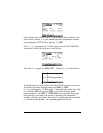
Page 16-71
These results indicate that (Δx)
next
= 0.00558… and that the RKF method
(CURRENT = 1) should be used.
Function RKFERR
This function returns the absolute error estimate for a given step when solving a
problem as that described for function RKF. The input stack looks as follows:
2: ʳʳ ʳ {‘x’, ‘y’, ‘f(x,y)’}
1: Δx
After running this function, the stack will show the lines:
4: {‘x’, ‘y’, ‘f(x,y)’}
3: ε
2: Δy
1: error
Thus, this function is used to determine the increment in the solution, Δy, as well
as the absolute error (error).
The following screen shots show the RPN stack before and after application of
function RKFERR:
These result show that Δy = 0.827… and error = -1.89…×10
-6
.
Function RSBERR
This function performs similarly to RKERR but with the input elements listed for
function RRK. Thus, the input stack for this function will look as follows:
2: {‘x’, ‘y’, ‘f(x,y)’ ‘∂f/∂x’ ‘∂f/vy’ }
1: Δx
After running the function, the stack will show the lines:
4: {‘x’, ‘y’, ‘f(x,y)’ ‘∂f/∂x’ ‘∂f/vy’ }:
3: ε
2: Δy
1: error


















